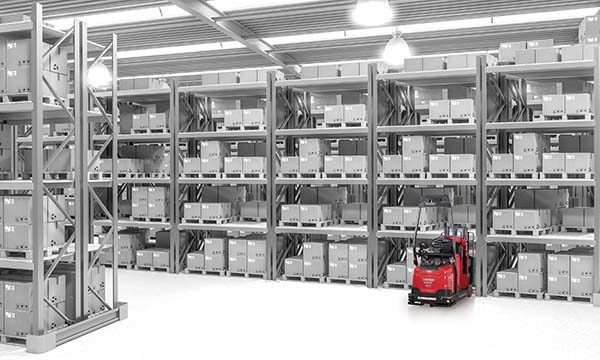The robots are here. Now what?
There’s more to automating warehouse operations than simply swapping in bots for humans. It also requires new workflows and a change management plan.

Warehouse jobs have been hard to fill this year, with distribution center managers pointing to a long-term logistics labor shortage that’s been exacerbated by pandemic disruption, an aging workforce, and a “gig economy” that offers short-term jobs for the taking.
Conventional wisdom says that automation is the answer, filling the labor gap with autonomous mobile robots (AMRs), robotic picking arms, and other such devices. The standard pitch for those automated platforms is that they can take over menial and redundant tasks, freeing up workers for more complex and creative jobs.
However, experienced pros say the solution is more complicated than just “hiring” a robot to handle simple tasks and promoting the people who used to do them. That’s because in real-world applications, adding automated equipment to the DC triggers a cascade of changes, such as shifting established workflows or creating hybrid jobs that didn’t exist before.
And because those new workflows have completely changed the way work gets done, warehouse managers may not be able to use standard tools like labor management system (LMS) software to reassign employees to new tasks. An LMS is a powerful platform for measuring labor performance against defined standards, but applying advanced technology to the DC often upends many of the assumptions on which those platforms were built. Over the long term, managers can reconfigure an LMS to allow for those changes, but first they need to explore the impacts of adding robots to the process.
A COMPLICATED EQUATION
The creation of hybrid jobs is one example of why there’s no simple equation for swapping out people and machines, according to the logistics and transportation service provider DHL. Technology has made great strides in recent years, but most sites are still nowhere near the stage where a “dark warehouse” can operate entirely without humans, executives from DHL said in a recent webcast from its Americas Innovation Center in Chicago, the company’s test bed for running pilots of advanced equipment.
“It’s going to be a little while before we see lights-out automation,” Klaus Dohrmann, vice president innovation Europe and trend research in DHL’s cross-divisional Customer Solutions & Innovation (CSI) unit, said in the webcast. “For the next 10 to 20 years, organizations will be looking to augment jobs, more than replace them with technology.”
That augmented approach is needed because logistics jobs are often highly complex and variable, adds Derrick Miller, regional sales manager for The Raymond Corp.’s iWarehouse division, which encompasses the lift truck company’s warehouse automation products, including its labor management system (LMS) and other software.
Technology is good at helping workers cut down on repetitive travel—such as pushing carts or driving forklifts down DC aisles—but those discrete actions are usually just components of more complicated overall processes. “Automation works well [when things are operating with clockwork precision], but you still need [human] labor when there’s nuance, such as when a pallet wasn’t wrapped correctly or when you need value-added activities like packing, kitting, or hands-on work,” Miller says.
That wide variability in work demands means that the best way for a company to optimize its overall operation is usually to help employees complete specific tasks faster, not to replace an entire job category. “Almost always, you see the impact of adding automation is to reallocate labor, handle natural attrition, or address a shortage that already exists, not simply cut jobs,” Miller says. “So the best solution will be people and automation existing in tandem. [DC operators] can eliminate wasteful steps not by eliminating an entire process but by replacing a component of that process [and] then having hybrid operators.”
In that manner, employers can adjust warehouse workers’ jobs to eliminate only the repetitive parts, not the entire role. And in turn, that segmented approach can help companies realize a faster return on their investment in automated systems, he says.
THE CHANGING JOB DESCRIPTION
In addition to boosting productivity, introducing automated equipment that relieves human workers of repetitive and physically demanding tasks can help with employee retention—a chronic concern for DC managers even before pandemic times.
But to reach that goal, many employers need to do a better job of communicating with employees and managing the transition process, says Dan Gilmore, chief marketing officer at Softeon, which offers warehouse automation software and other products. “Focus on the worker, and their receptivity and benefits from the automation, and you’ll get retention,” Gilmore says. “But you need to communicate the benefits of automation—that it will make your job easier and better.”
Blending automated systems with human labor on the warehouse floor is particularly critical at times like these when the industry is facing an epic labor crunch, says Madhav Durbha. Durbha is vice president of supply chain strategy at Coupa Software Inc., which provides spend management software and in 2020 acquired the LMS and supply chain software developer Llamasoft.
“Warehouse labor is [a sector] with high turnover,” Durbha says. “The pace of warehouse automation is being outstripped by the increased demand and consumption patterns, and one can’t hire fast enough to make up for the turnover. Because of this, in the short term, there is still plenty of room for the warehouse labor to work alongside robots rather than be replaced by them.”
Over the longer term, as robots take on more of the mundane daily tasks, those warehouse workers can be reassigned to higher-level tasks such as sorting e-commerce returns or troubleshooting balky robots, Durbha says.
While current economic trends continue, today’s powerful warehouse automation tools hold enormous potential for supercharging the productivity of logistics and fulfillment workers, not replacing them. Taken together, the pandemic-induced staffing challenges and the boom in e-commerce sales have created red-hot labor demand. And in response, warehouse captains are calling for “all hands on deck” to meet the need, whether those hands are human, robotic, or an all-star combination of both.Related Articles

Copyright ©2024. All Rights ReservedDesign, CMS, Hosting & Web Development :: ePublishing